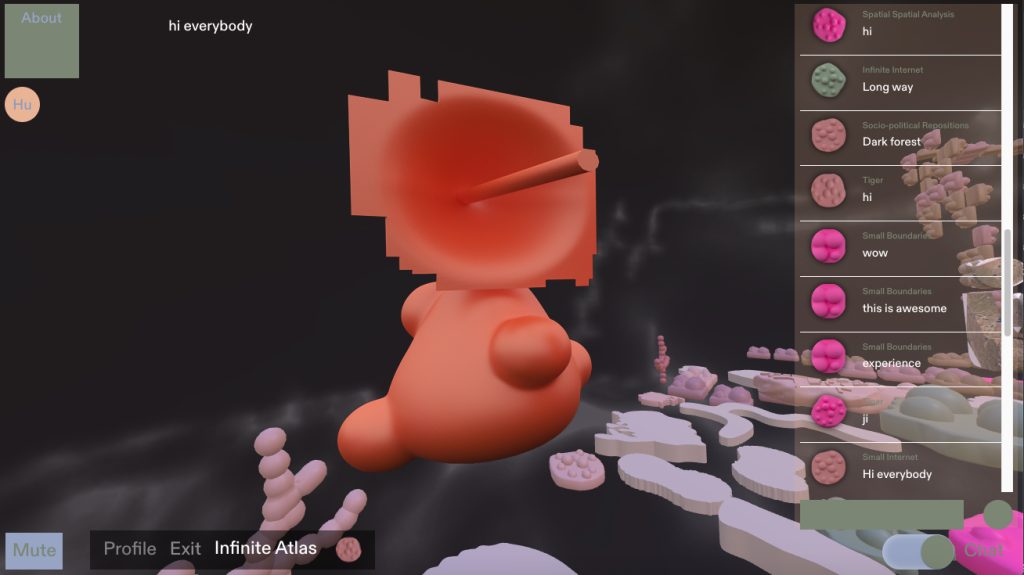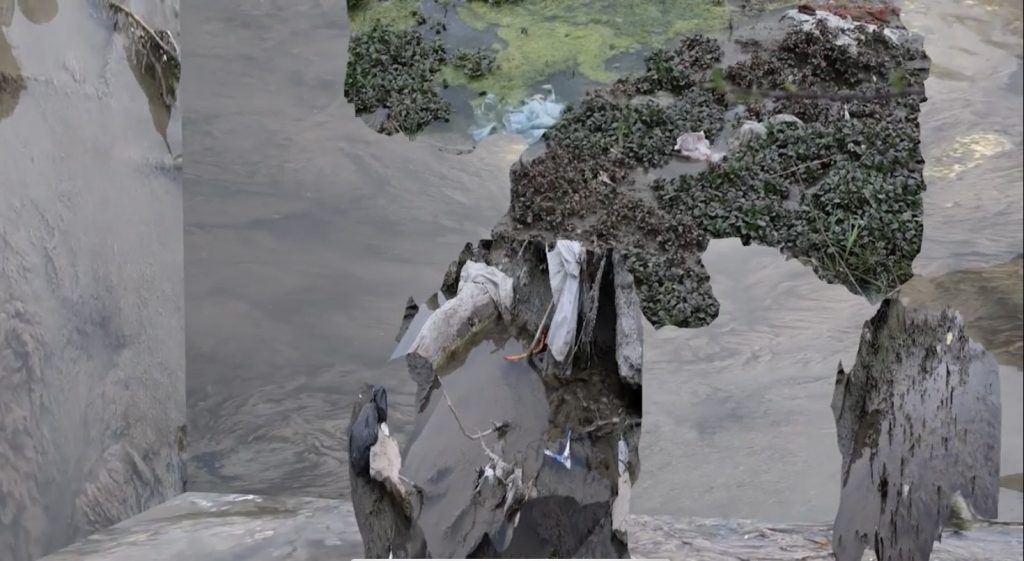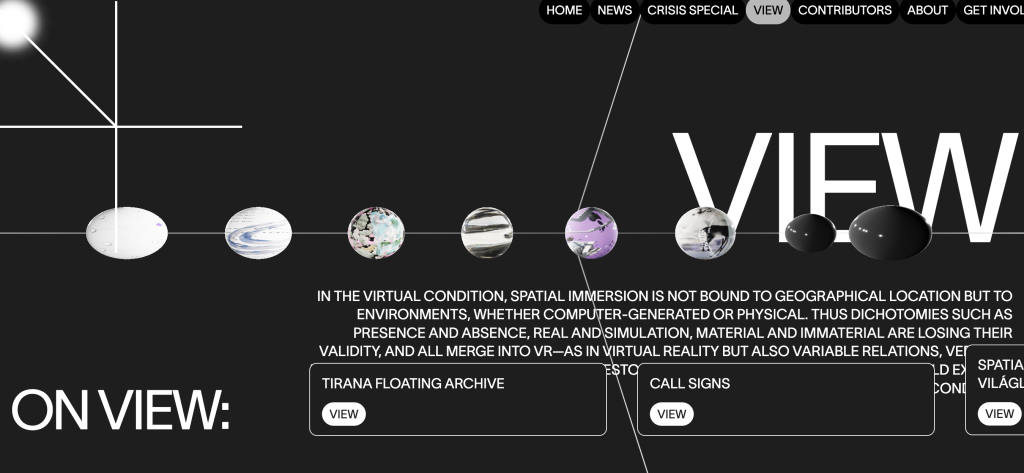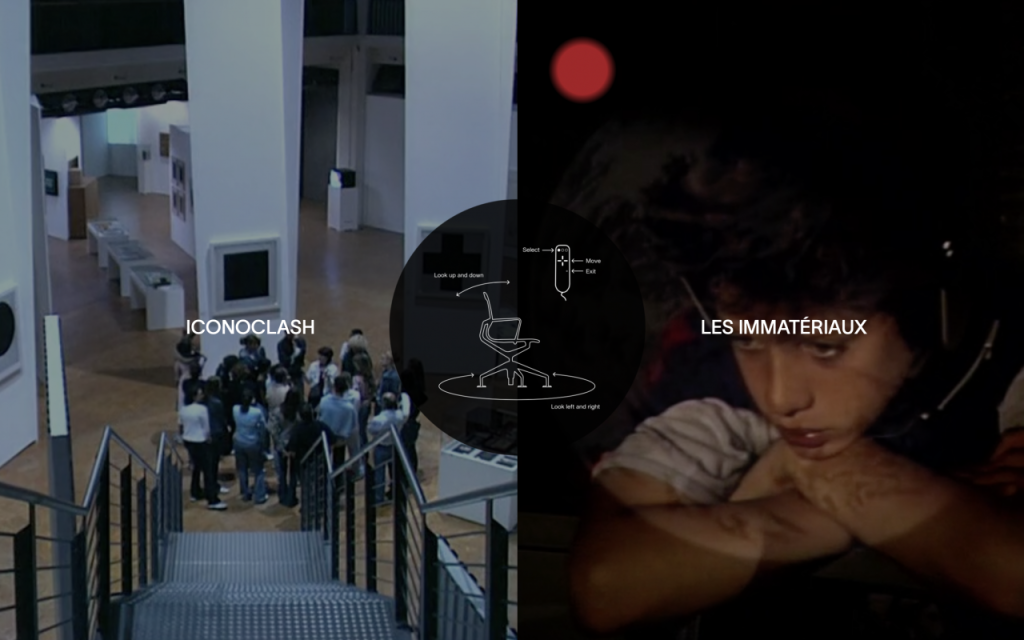Interview by Daniela Silva

Lívia Nolasco-Rózsás is a curator and researcher from Hungary with work developed at international contemporary and media art institutions. Her interest in the constantly changing media of contemporary art and its intersections with political science and technology has led her to develop thematic exhibitions that addressed issues such as the genealogy and social impact of planetary computation and computer code, electronic surveillance and democracy, functions and processes of science in relation to the automated economy, mediated visions of built environments, and synesthetic perception related to the integration of minority groups in contemporary art mediation.
Lívia strives to advance the museums of the future. Her current research investigates the “virtual condition” and its implications for exhibition spaces, developed in affiliation with the Academy of Fine Arts Leipzig under the supervision of Beatrice von Bismarck.
Her most recent curatorial project Beyond Matter is an international, collaborative, practice-based research project that takes cultural heritage and culture in development to the verge of virtual reality. Extensive research into the revival of past landmark exhibitions has led to the development of software and hardware that can be applied within the exhibition context. The outcomes of the research undertaken within the framework of the project will allow for the networked documentation of exhibitions that currently exist, or previously existed, in physical space – including their artworks, artefacts, and educational materials.
Beyond Matter draws attention to a shift in a condition that became unexpectedly relevant as the world went into lockdown in early 2020 due to the Pandemic. All cultural facilities – museums and exhibition spaces included – had to close their physical premises. However, they were still able to contact their audience online. Although spatial aspects form the essence and means of curating, presence seems to strike a deal with absence.
Exhibition spaces are physical environments where knowledge is created and exchanged, and spatial features play a significant role in the contextualization of data. Led by the ZKM | Center for Art and Media in Karlsruhe, Beyond Matter enjoys a close cooperation with the Centre Pompidou in Paris, the Tallinn Art Hall, Tirana Art Lab, the Ludwig Museum in Budapest and the Aalto University. The common goal of the partners involved in the project is to develop a basis for the development of both museological and technological aspects that will aid in the digital transformation of museums.
In the future, museums and galleries may be able to benefit from the newly developed methods emerging from projects such as Beyond Matter and apply the experiential, research-based methodologies within their own premises – be it in physical or virtual space.



For those who are not familiar with this research project, can you talk more about the initiatives within the framework of Beyond Matter?
The project encompasses a broad spectrum of initiatives, all of which serve as case studies and contribute to the research being conducted within the framework of Beyond Matter, which explores the possibilities of computer-generated spaces for curation and art mediation. In doing so, we are treading on territory that is relatively new for art institutions.
Our aim throughout this exploration is to generate new worlds instead of conquering pre-existing ones. Be it through the modelling of past exhibitions, or inviting artists to elaborate their take on the virtual from diverse angles, the notion of space and its meaning in the context of artistic and exhibition practice, as well as the political dimensions of computer-generated and physical exhibition spaces, are key areas of focus within the project.
Beyond Matter is a multilayered project that relies on the collaboration between nine partners from seven European countries. They are institutions of various scales and profiles with a shared interest in the innovative use of technologies through which to reach non-local audiences with content that is equally as appealing as that which is contained in physical exhibitions. This is the incentive which we keep in mind while working on the different outputs of the project.
The exhibition Spatial Affairs and its online counterpart Spatial Affairs. Worlding, is a concrete example of one such collaborative endeavour between the Ludwig Museum Budapest, the ZKM | Karlsruhe, and EPFL Pavilions, along with the input from Aalto University fellows.
The goal of the Spatial Affairs exhibition is to analyse the relationship and mutual dependence of physical and digital presence through works of conceptual and contemporary art, as well as manifestos. The presented positions from the pre-and post-emergence of computer technology share a common trait regardless of their medium: they all examine the development and social impact of science and technology through the notion of space, thereby pointing out the co-dependency between the tangible real and the intangible digital.
Both exhibitions are available online and can be accessed through the VIEW platform of the Beyond Matter project Guided tours through the digital exhibition spaces are offered on the regular. Spatial Affairs and the Hybrid Museum Experience Symposium (HyMEx), which was developed parallel to the exhibition in 2021, both laid the groundwork for the investigation of exhibition spaces.
Through a collaboration between the ZKM | Karlsruhe and the Ludwig Museum Budapest, HyMEx explored how the walls of exhibition spaces potentially dissolve and instigated a discussion about how museums can react to this flourishing phenomenon. The proceedings of the symposium are available for download, and contain, contributions from Christiane Paul, Peter Weibel, and Boris Groys, to name but a few.
What do you believe to be the biggest ambition of the project?
The exploration of the potential of computer-generated exhibition spaces for art institutions lies at the heart of the project. The aim can be summarised in one sentence, but to investigate the multiplicity of these potentials with one single approach or a sole project is impossible. Thus, the architecture and also the project outputs of Beyond Matter are complex, nuanced, and utterly pluralistic.
Broadly speaking, all of the case studies offer pioneering solutions for online exhibitions, the modelling of past exhibitions, as well as the networked presentation of born-digital artworks that operate in digital space. The results deriving from the various activities are being thoroughly documented and will be published in online and offline formats by the end of the project.
Furthermore, some of the activities aim toward the creation of tools that can be used beyond the scope of the project by other museums. The software solution with which past exhibitions can be modelled, for example, will be released and can be used by other museums for their own shows.
We aim to gather and share knowledge about digital practices in contemporary art, past and digital futures of exhibitions, and their mediation. This ambition is crucial, even if we know that our work might become obsolete sooner or later due to the rapid development of computation.
The installation Immaterial Display is part of the itinerant exhibition Matter, Non-Matter, Anti-Matter. In this installation, past exhibitions are to be made re-experienceable through VR technology, an attempt to make knowledge and history a sensual and multilayered experience. What other advantages do you envision from this technology in the context of art production, curating, and mediation?
Central to the exhibition Matter, Non-Matter, Anti-Matter is the so-called Immaterial Display. It is a custom-made interactive installation that was created for one sole purpose: to showcase digital models of exhibitions in a museum environment in an immersive way. The Display consists of a double-sided monitor panel and a chair with a hand-held controller, so it is not using VR tech per se.
The two past exhibitions we chose as case studies are Iconoclash. Beyond the Image Wars in Science, Religion and Art (2002, ZKM | Karlsruhe) and Les Immatériaux (1985, Centre Pompidou Paris). Both were landmark exhibitions of their time and both were based on complex curatorial concepts that didn’t only focus on art but on broader questions concerning materiality and representation.
After these shows were dismantled only their fragmentary documentation and catalogues remain, none of which reflect the spatial qualities, which were pivotal to the respective exhibitions.
Both of these exhibitions, particularly Les Immatériaux, have been garnering the interest of researchers for decades. The research interest lies in the exhibition-making traditions that grew out of modernity and evolved into post- and non-modern curatorial approaches. Therefore the institutions where these exhibitions took place took the responsibility into their own hands and invested time and energy into the re-accessibility to these shows.
So, our approach adopts curatorial concepts that are deployed in physical exhibition spaces of museums and art institutions and transpose them into digital spaces that are created in the process. It thereby contributes to the conservation of a very specific type of intangible cultural heritage, namely the spatial arrangements of interpretable objects.
It also makes these past exhibitions, or at least their models, accessible to a wider public, not only to specialists in the field. Since they will be accessible online, the institutions will be able to mediate them just like any other online exhibition. In this sense, we multiply the exhibition spaces, since these curatorial projects get suspended in time and can be re-accessed, and also re-interpreted.
We hope to widen the scope of possibilities in exhibition-making, conservation, and access. In the long run, this shall have an impact on artistic, curatorial and mediation practices, but more concretely on the reception of these exhibitions.
This project explores the constantly changing media of contemporary art and the intersections with various disciplines. What have been the biggest challenges you faced? What’s coming next for the project?
The biggest challenge so far has been to find like-minded collaborators from the technological sector who understand the obstacles connected to this endeavour and are willing to experiment and build something new with us. It has been a demanding process, but in the end, we were able to find the fitting contributors.
Another challenge we have faced since the beginning has been the steering of the PR and marketing machinery of the participating museums in a way that effectively communicates online productions. Museums generally focus on bringing the visitors physically into their premises, and non-local, i.e. online visitor numbers, are taken less into consideration.
Although in the third year of the pandemic, this is not entirely true anymore, online activities and visits are becoming key figures in museum statistics. Beyond Matter started shortly before the pandemic, at a time when the topic of digital transformation in museums was picking up speed.
Due to lockdowns, curfews, and social distancing, this has been accelerated and museums are drawing their attention to their non-local visitors stuck at home. This shift will have a long-term impact and will need to become part of the toolkit of art institutions. Therefore the focus on online mediation has been fruitful ground for our endeavours and has also broadened our horizons.
What do you think the next emerging technology is, the next shift, within the artistic and museological practice?
Technology-based immersion and thus the dissolution of the interface is currently experiencing momentum within the exhibition space. Immersive installations often operate on a purely sensory level and might not offer enough room for critical reflection. This is why we would like to investigate the political dimensions of immersion through contemporary works of art in an international group show we will curate together with Corina Apostol at the Tallinn Art Hall in 2023.
The other emerging technology I currently see spreading in the exhibition context is Augmented Reality, which is in line with the immersive tendencies. What I like about it is that it can be used as a layer beyond physical exhibitions, as a sort of blanket of digital fog that sits on physical works, and eventually, comments complements or simply coexists with them.
We will experiment with this approach in the upcoming iterations of the exhibition Matter. Non-Matter. Anti-Matter is currently being developed in close collaboration between Marcella Lista, Philippe Bettinelli and Julie Champion from the Centre Pompidou in Paris, and Felix Koberstein, Moritz Konrad, and myself from the Beyond Matter team at the ZKM.
Lastly, throughout the course of Beyond Matter, we’ve been working with algorithmic tools as a way to personalise exhibition models, which can be considered a type of artificial intelligence. AI and other developments in computation, such as quantum computing, are already having an impact on exhibition spaces, museums, and art mediation. However, we’re still far from the stage where museums are truly cognitive systems of their own.
I’d argue that the clash between the current state-of-the-art information technology and art creation and mediation can be summarised as a “Virtual Condition” in which the reciprocal relationship between computer-generated spaces and the immersive features in them appears to be a key aspect of art production and mediation, at least for the time being wherein the distinction between generated and “natural” is still possible and has any importance.





